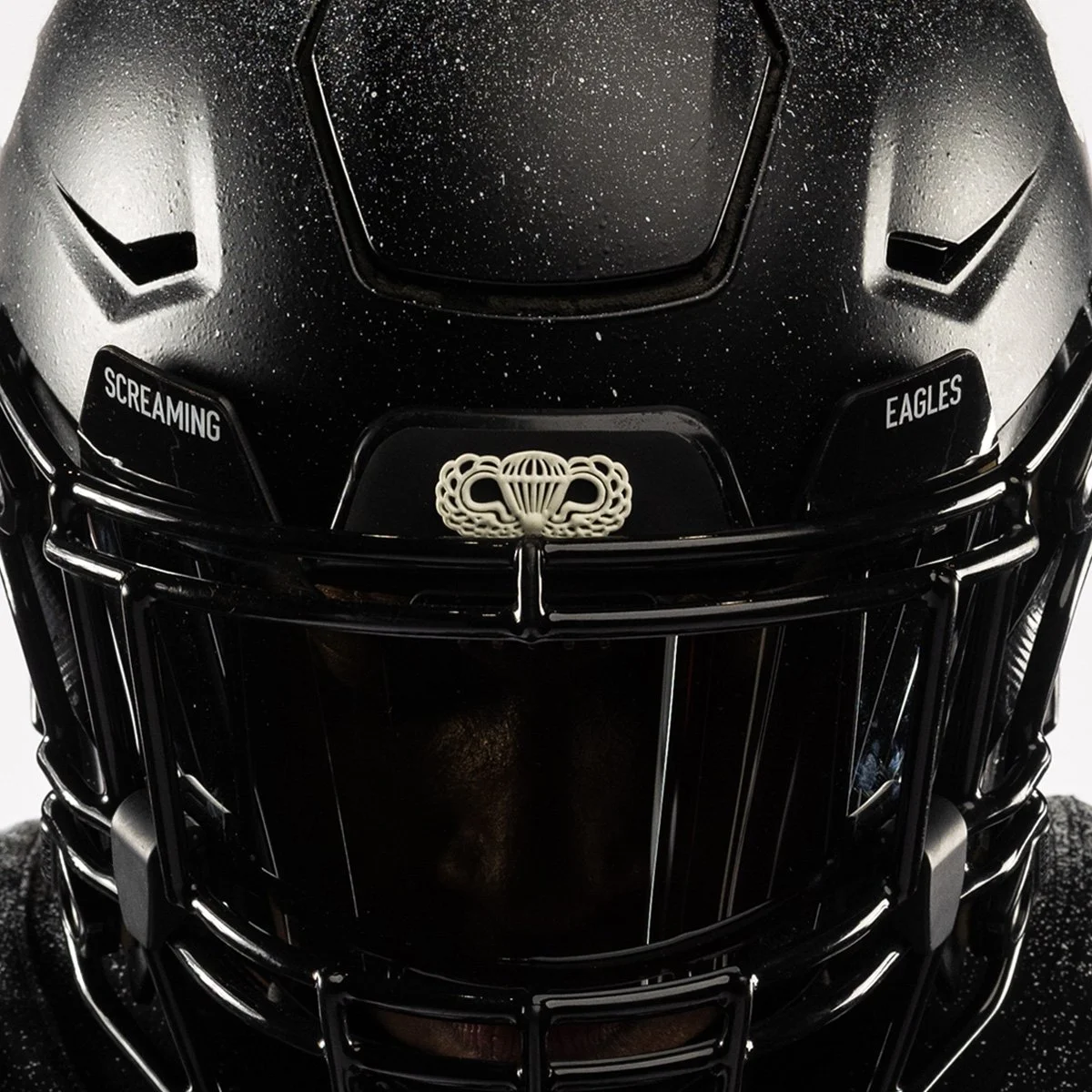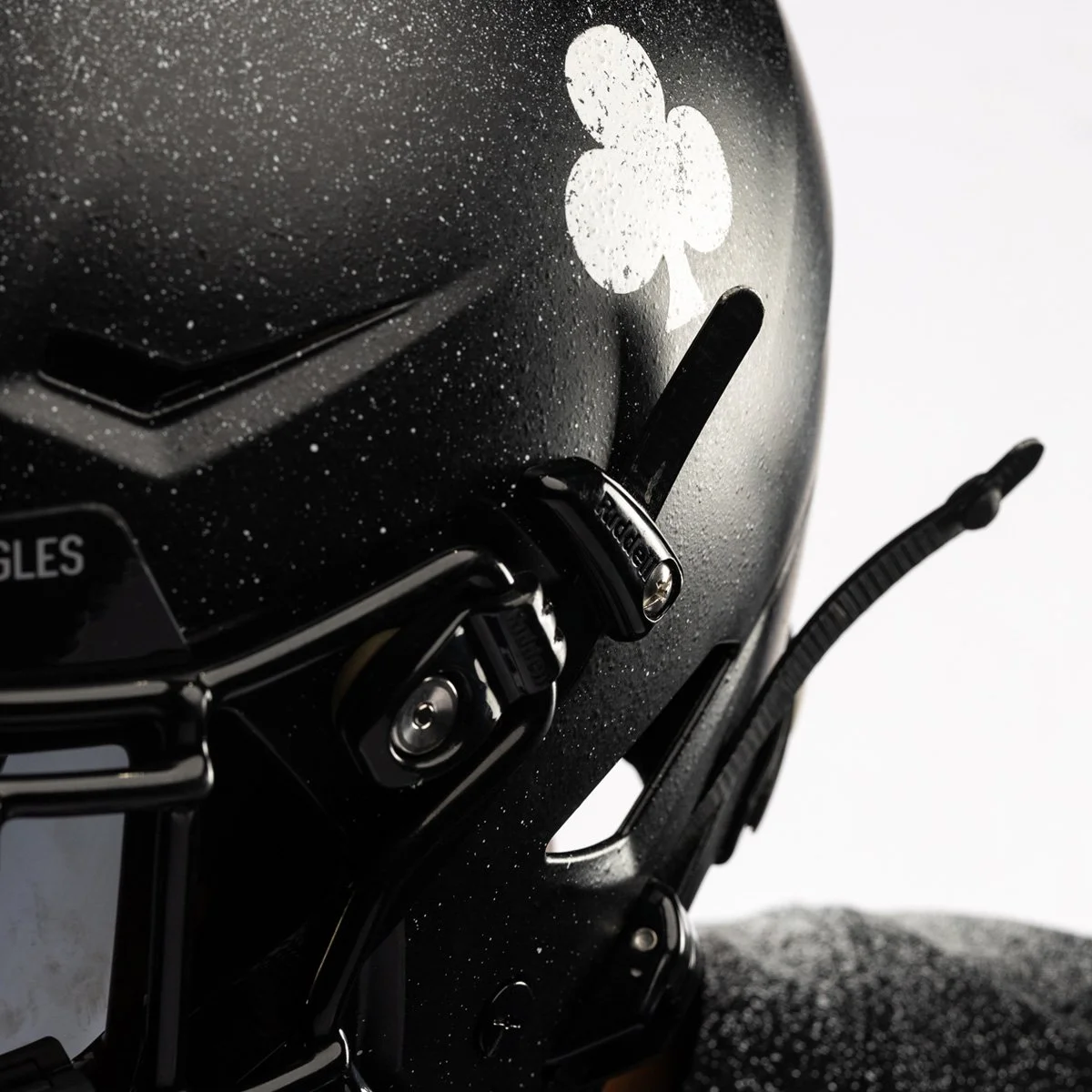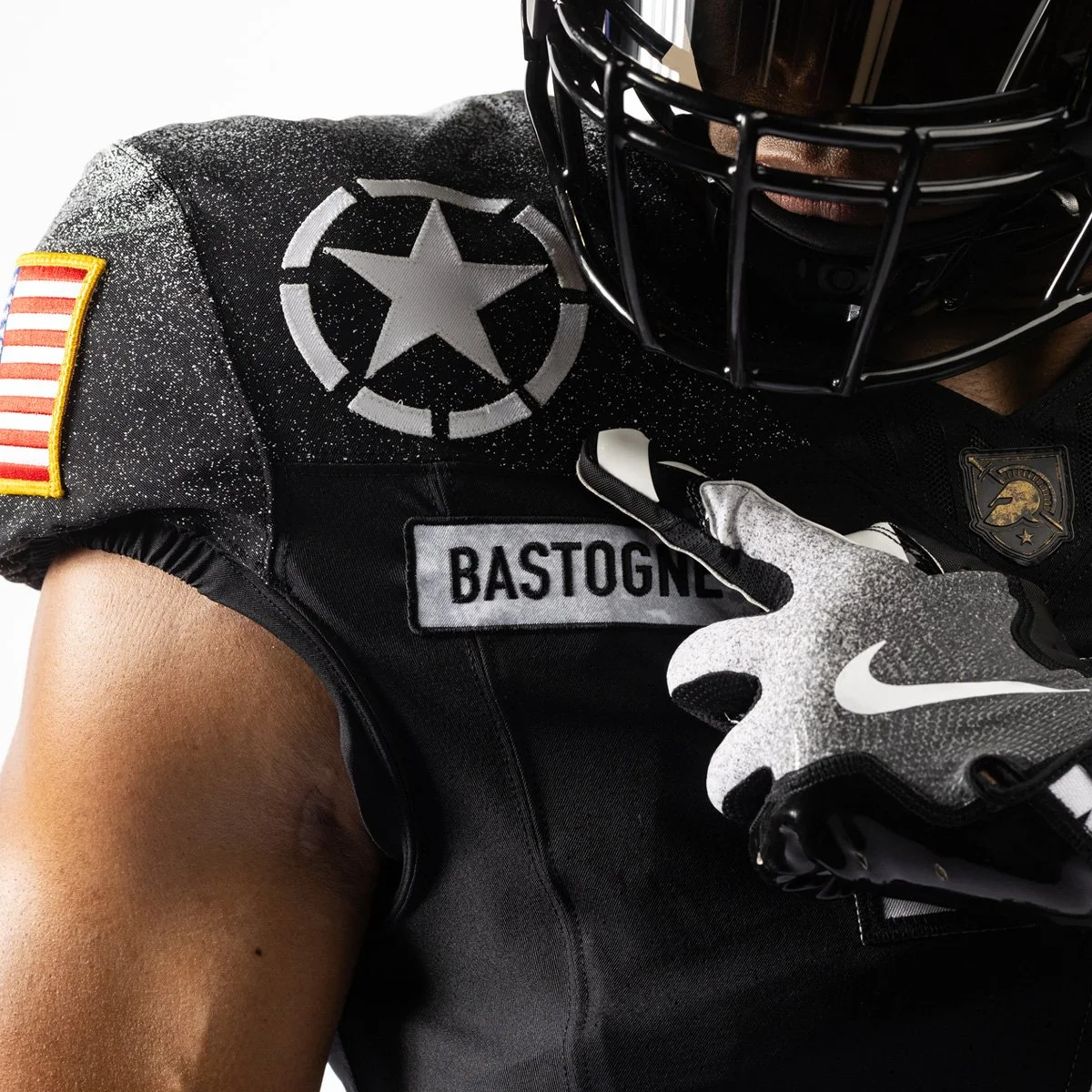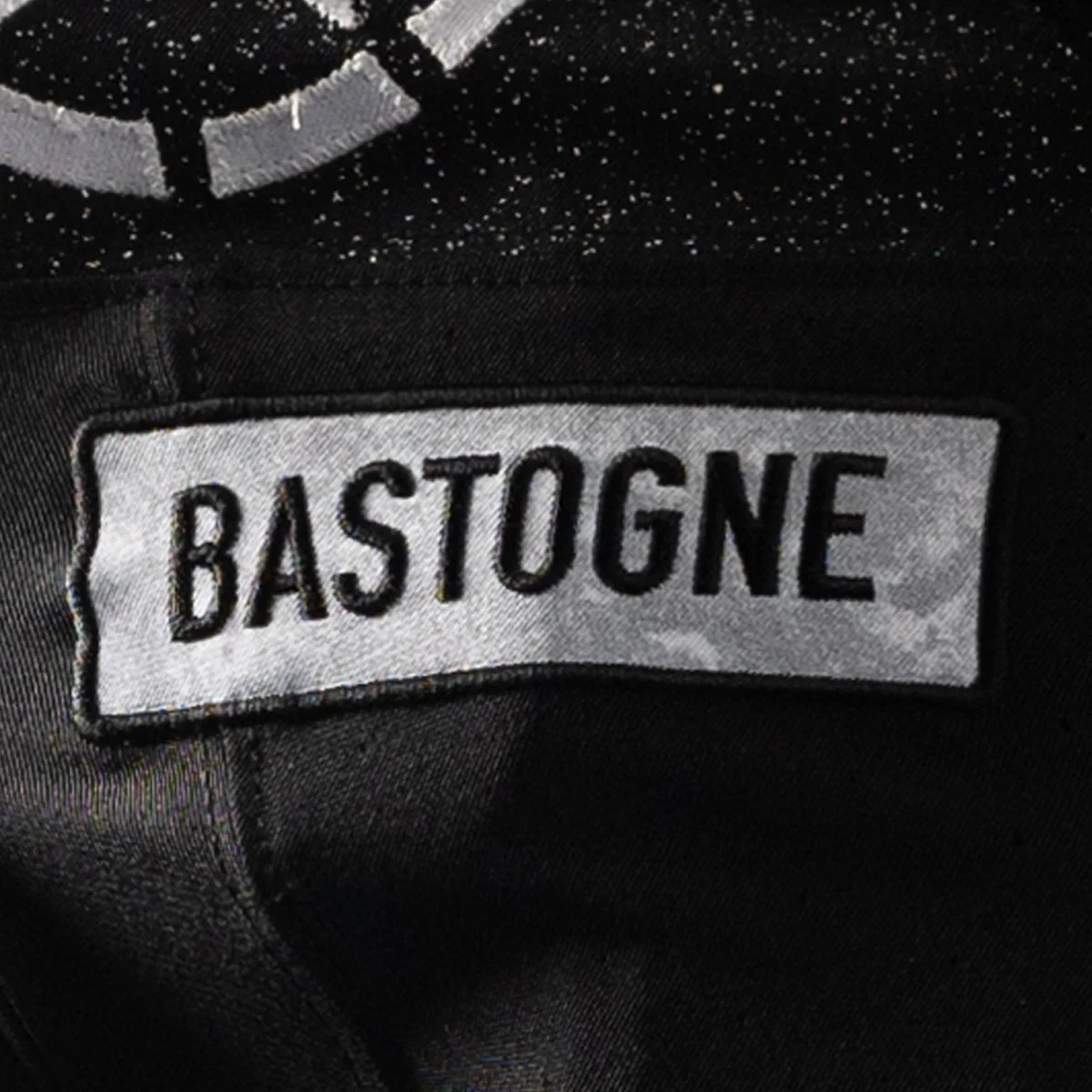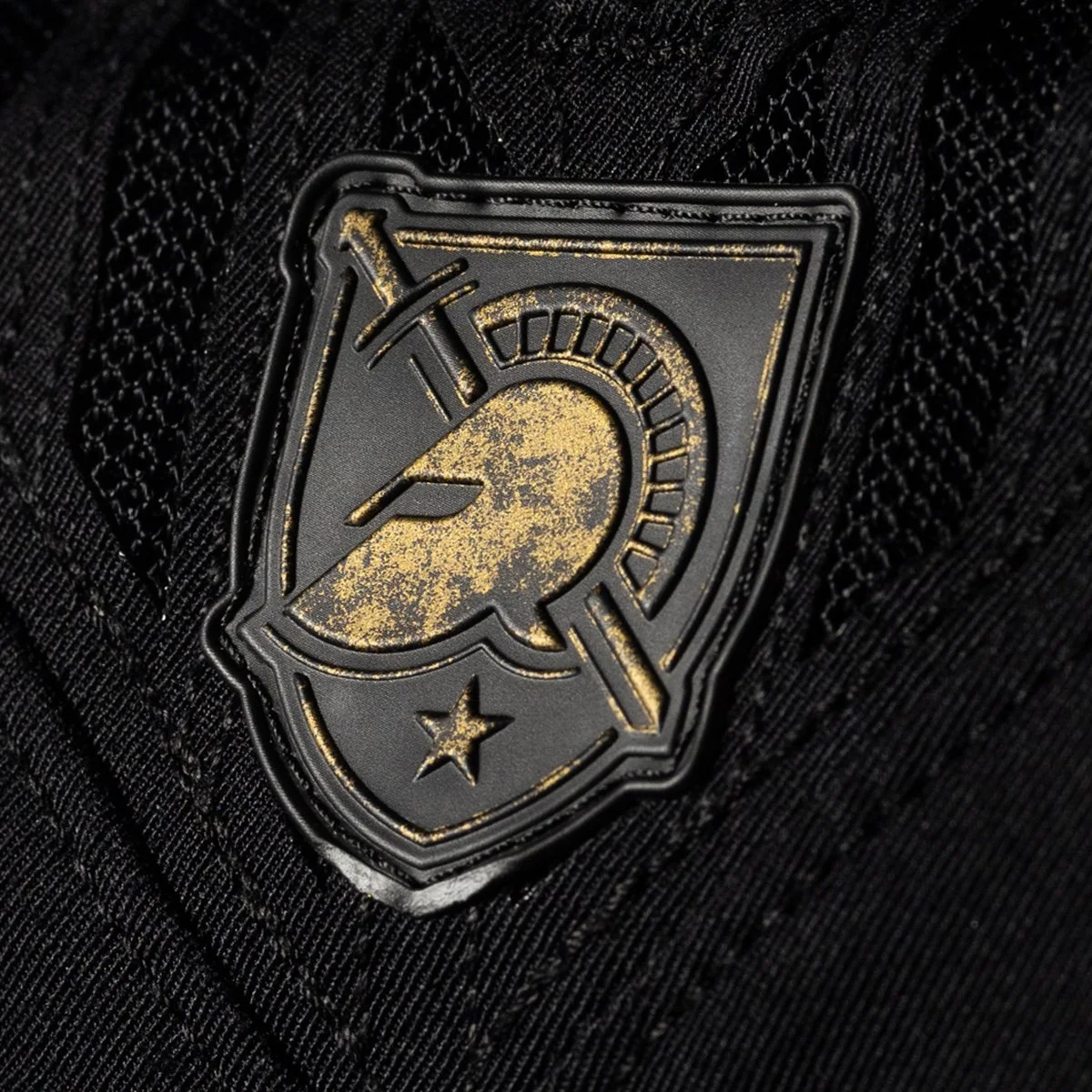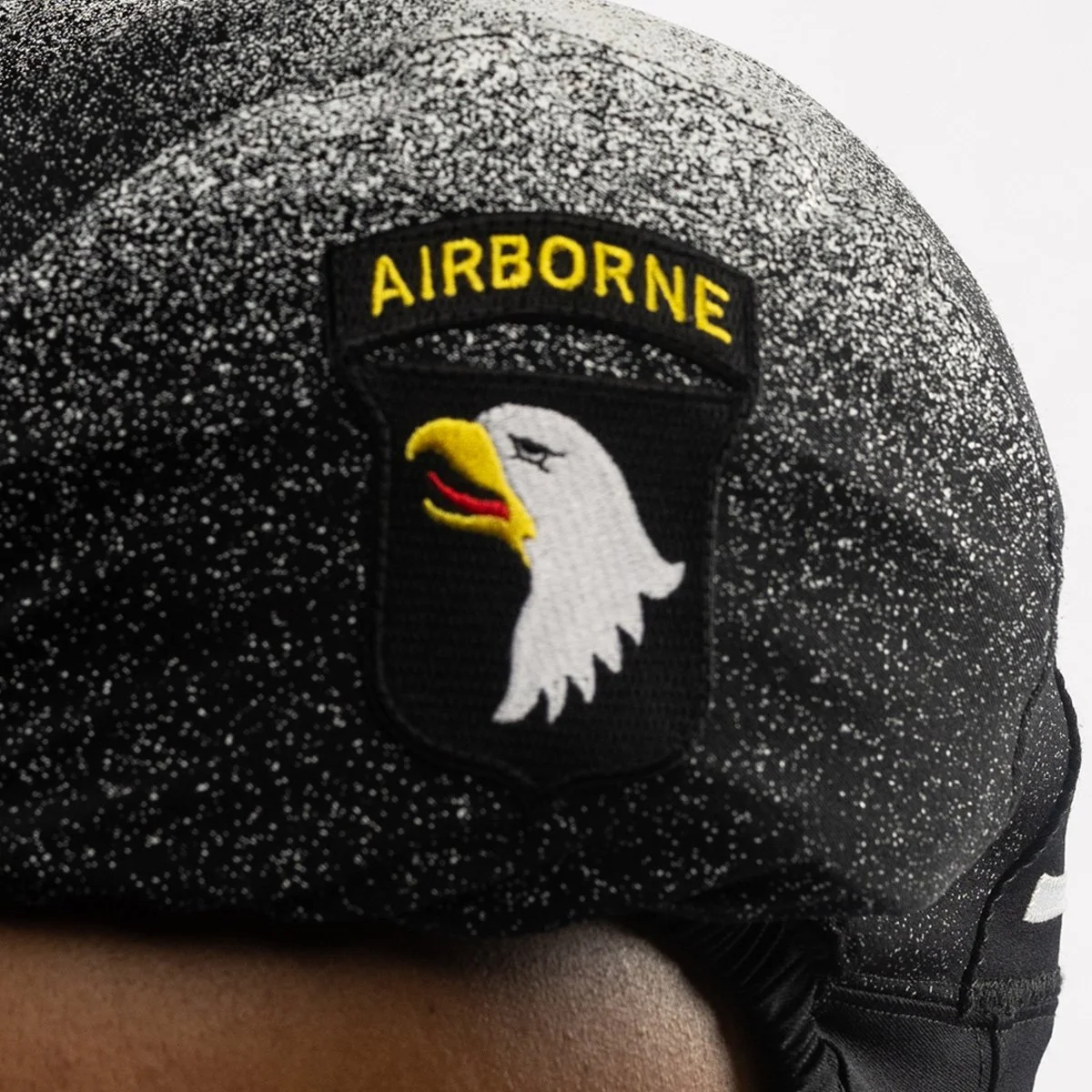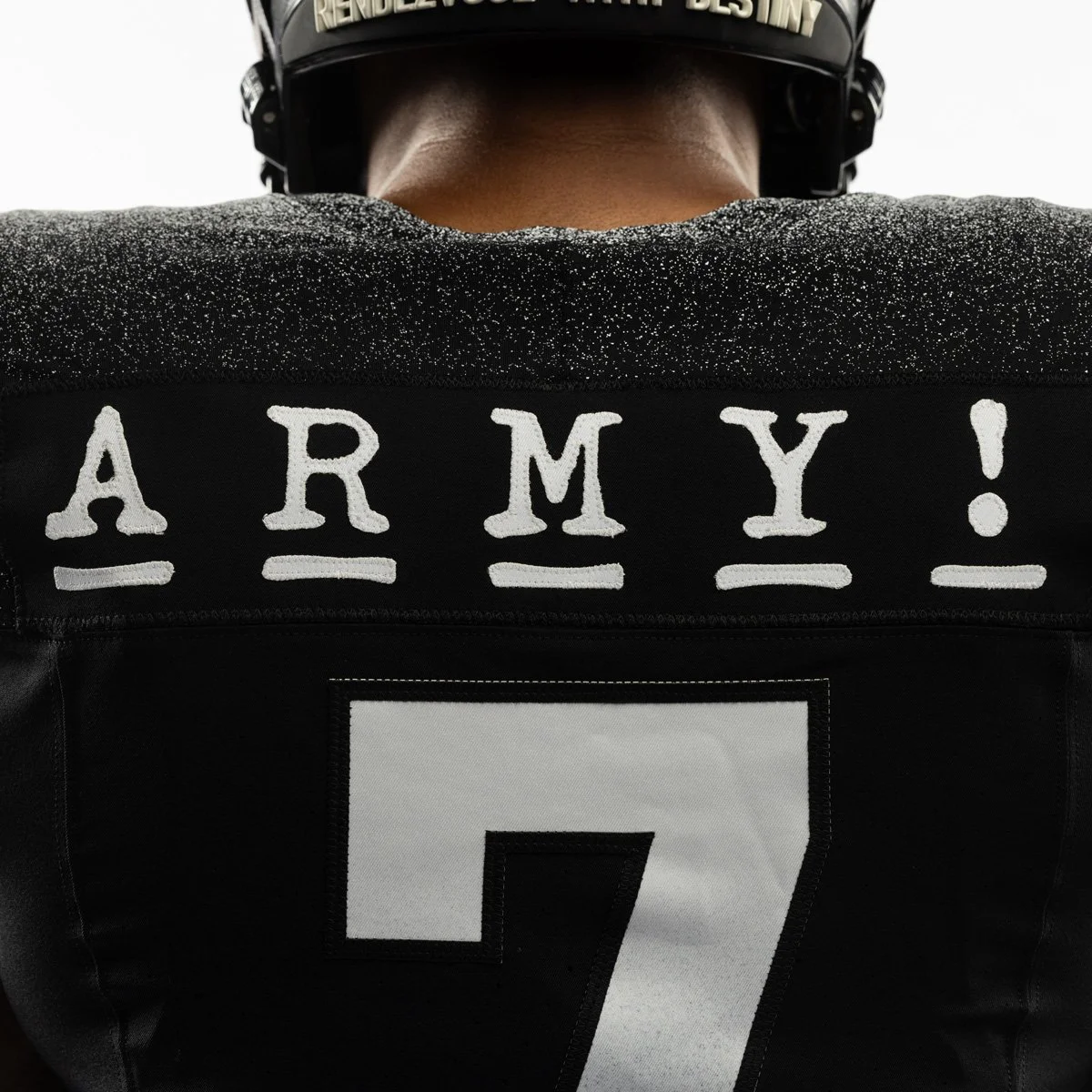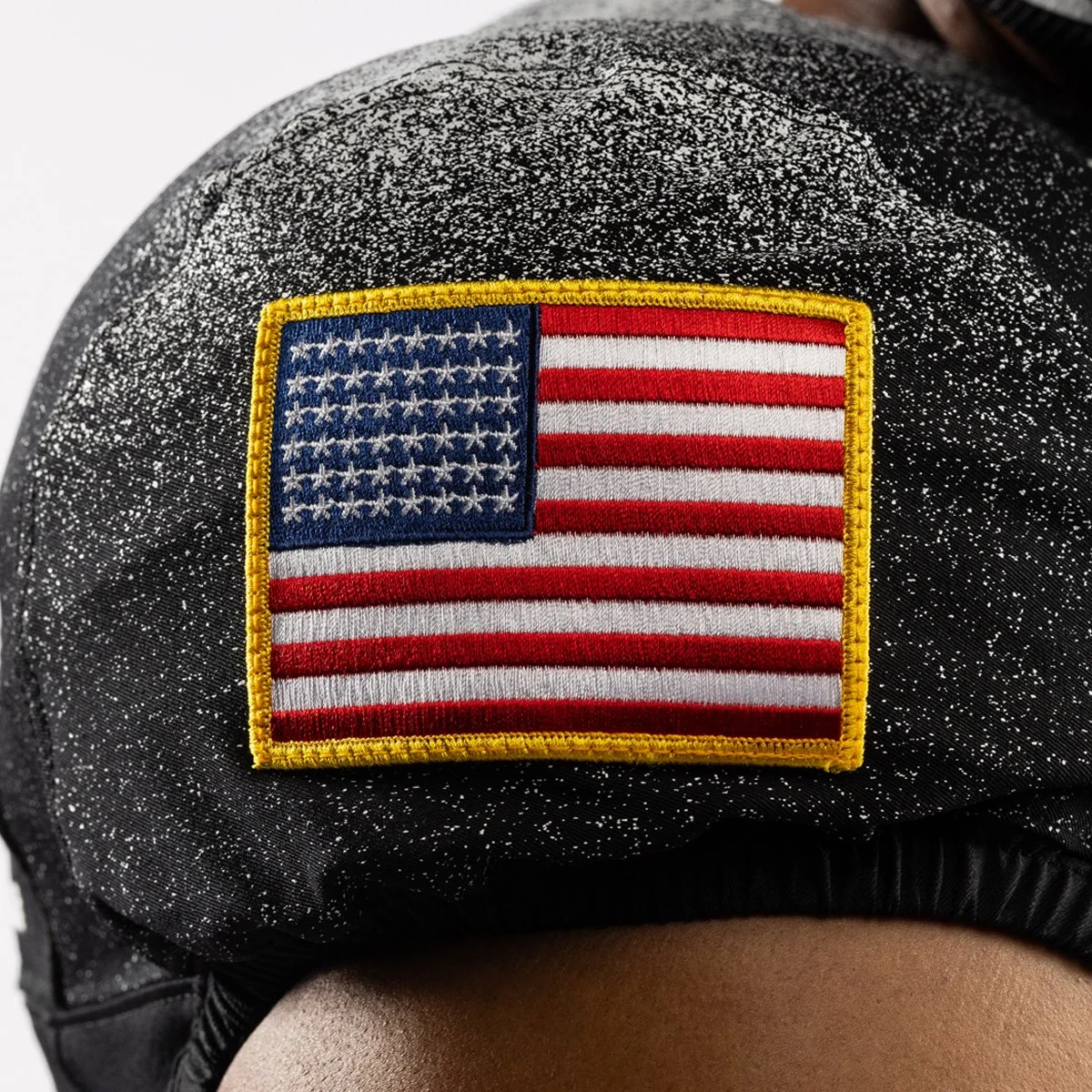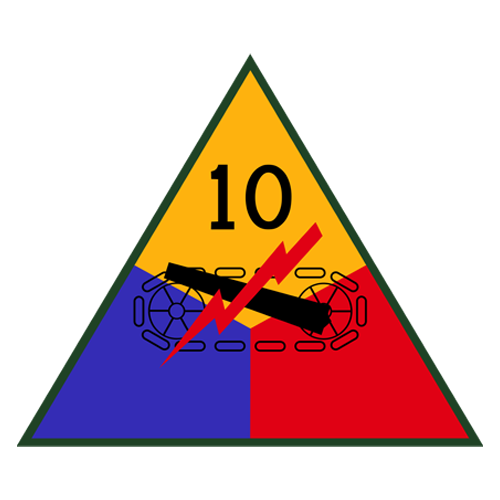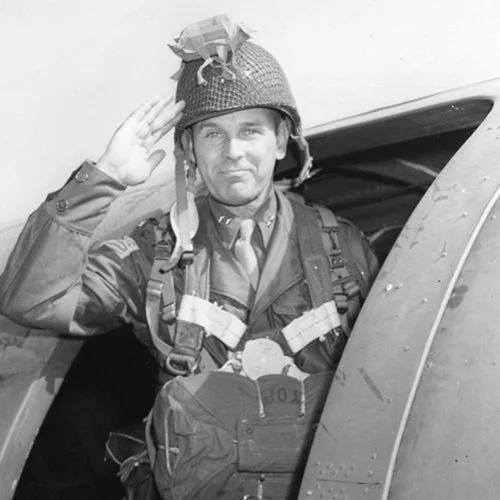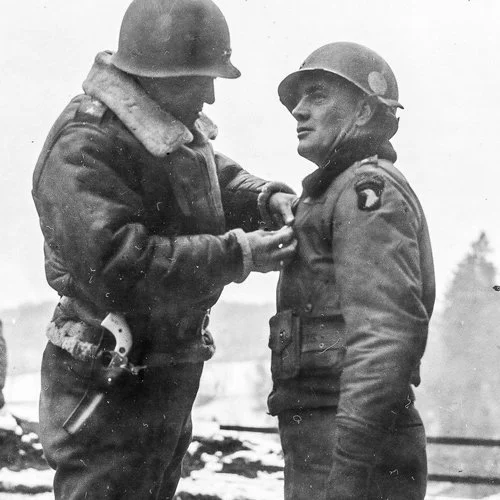

ARMY AND NIKE TEAM UP FOR 2024 ARMY-NAVY UNIFORM TO HONOR THE SOLDIERS OF THE 101ST AIRBORNE DIVISION
Rendezvous With Destiny
The 2024 Army-Navy uniform honors the storied legacy of the 101st Airborne Division. Nearly 80 years ago, the Screaming Eagles lived their motto, Rendezvous with Destiny, when they raced into the town of Bastogne in response to the Nazi offensive that would become known as the Battle of the Bulge. The 101st Airborne Division, encircled by Nazi forces, endured three weeks of relentless close combat in freezing weather.
Their endurance and outright refusal to surrender sapped Nazi morale and resources and played a significant role in the failure of the Nazi’s last great offensive in the Second World War.
On December 14, we are honored to represent the past, present, and future Screaming Eagles of the 101st Airborne Division. As we take the field against our rivals, we carry the paratroopers’ legacy and traditions with us as we seek to emulate their Rendezvous with Destiny by refusing to yield the Commander-in-Chief’s trophy.





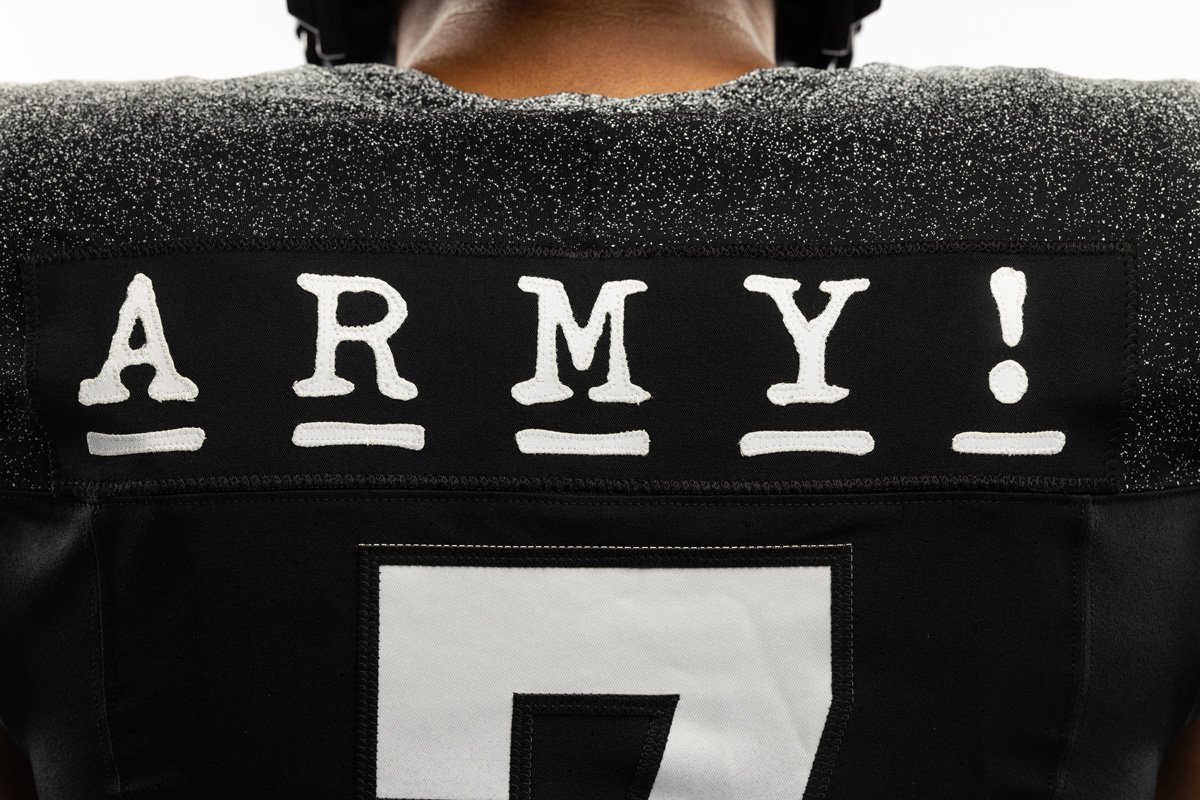
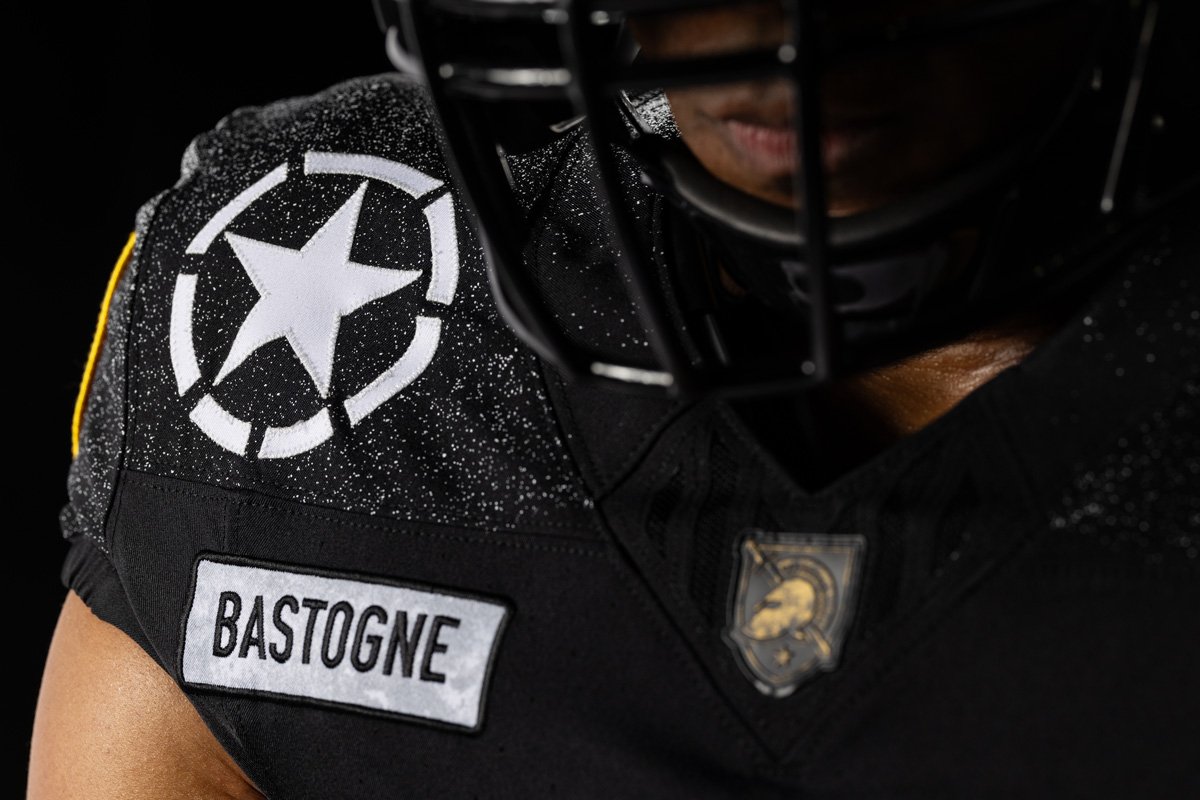
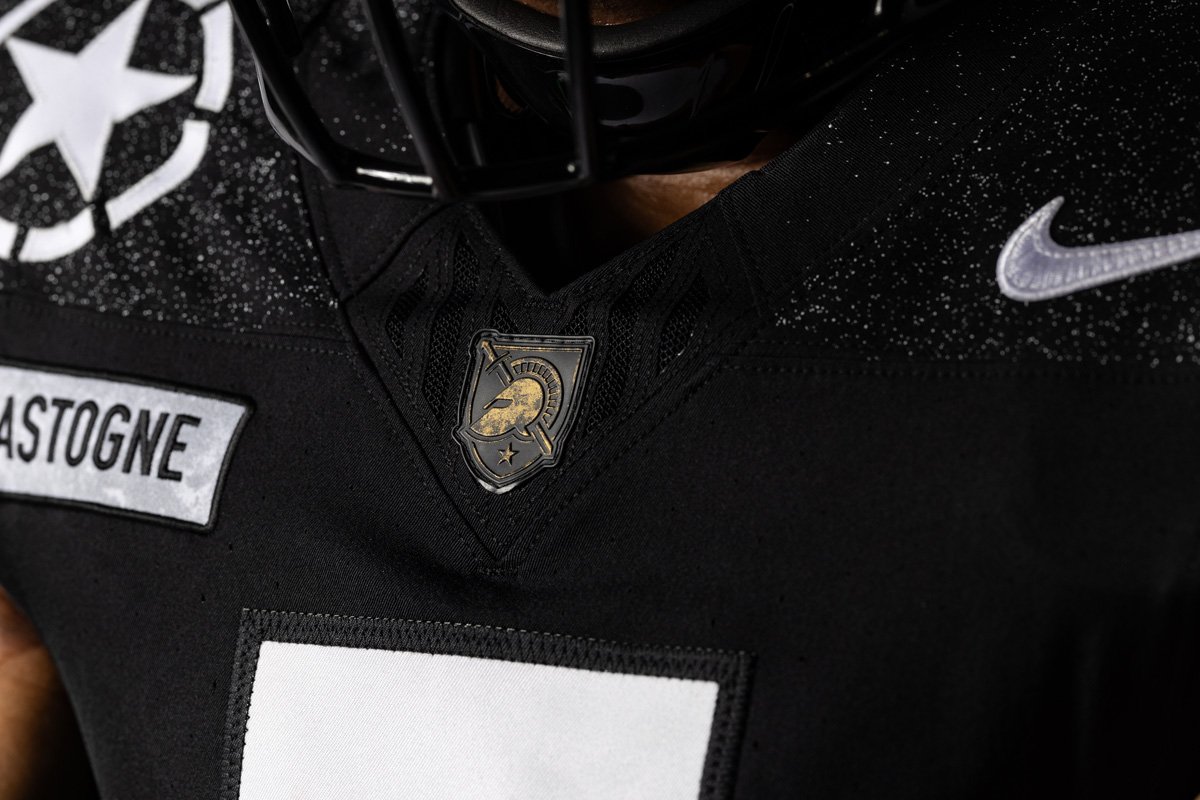

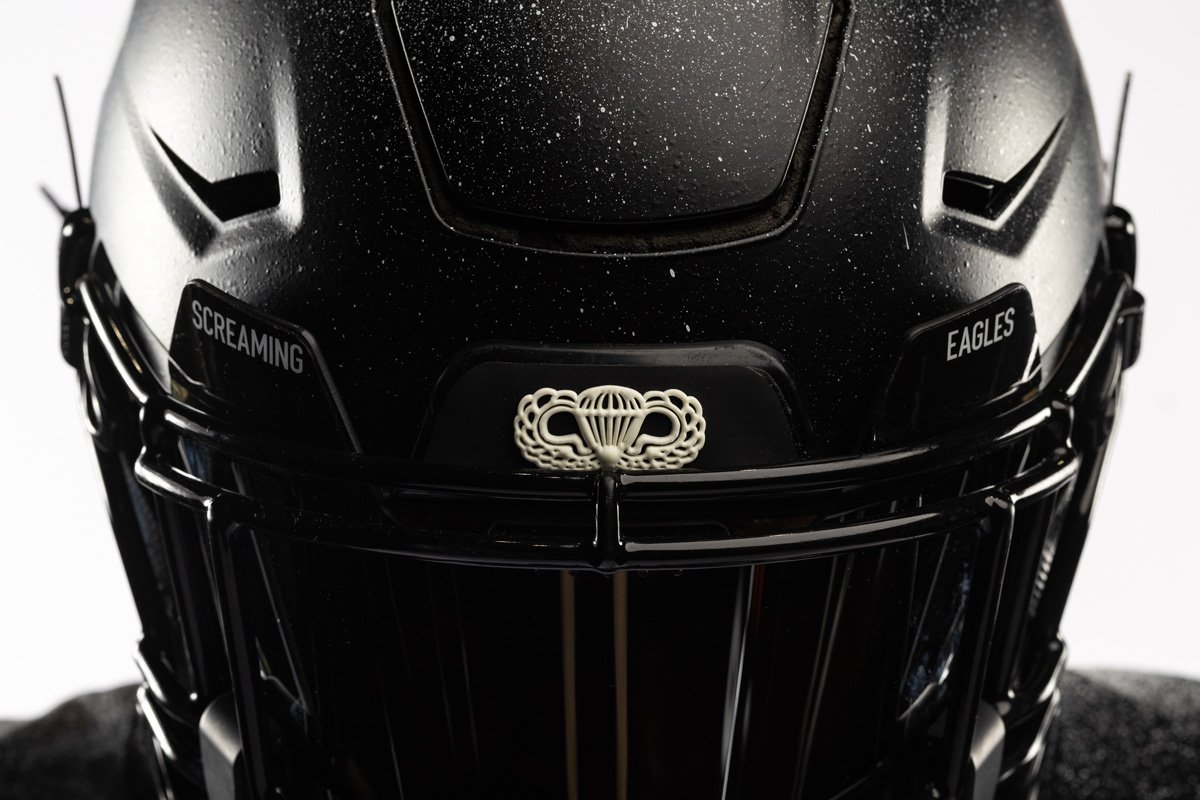
Battle of the Bulge and the Defense of Bastogne:
In the waning months of 1944, maneuver warfare had given way to a slow, grinding Allied advance into and through the Siegfried Line. This fighting, including the bitter fight through the Hürtgen Forest, exhausted troops and stressed logistical support on both sides, while convincing Allied planners that Nazi forces could not return to the offense. Desperate to force the British and Americans to make peace so that he could focus on defeating the Soviet Union, Adolf Hitler devised Unternehmen Wacht am Rhein (Operation Watch on the Rhine) to drive a wedge between the Western Allies.
Against six U.S. divisions, the Nazis managed to mass twenty-four, including ten Panzer divisions. They planned to attack during heavy snow and clouds to negate Allied air supremacy. They hoped to drive all the way to the Allied logistics base of Antwerp, but to get there they had to take Bastogne. The seven major roads meeting in the town made it crucial to maintaining Nazi momentum: while the Panzers and troops could travel off-road, supply trucks generally could not. Seeing the danger as Fifth Panzer Army smashed through initial defensive positions, General Dwight Eisenhower directed his two airborne divisions—his only strategic reserve—to rush to crucial points on the front. The 101st Airborne hurriedly entrucked, then foot-marched into Bastogne and the surrounding area to blunt and then stop the Nazi thrust.
At Bastogne, the 101st absorbed survivors of the previous days’ fighting, to include Combat Command B of the 10th Armored Division, who had fought a vicious delaying action to buy the 101st time to arrive, and the 969th Field Artillery Battalion, an African-American unit that formed the core of the 101st’s provisional artillery group. The paratroopers hurriedly integrated these forces and their knowledge into the defense of the town, against 5:1 odds and with no immediate hope of resupply or relief. Using interior lines, the defenders were able to rush what tanks they had left, along with artillery firing as anti-tank guns, to check repeated offensive thrusts. On 22 December Heinrich Freiherr von Lüttwitz, commander of the XLVII Panzer Corps, issued an ultimatum to the 101st’s acting commander, Brigadier General Anthony McAuliffe, and demanded surrender of the garrison. McAuliffe’s reply was one word: “Nuts!”
Successive attacks on Christmas Day briefly penetrated the 101st’s perimeter, but rapid responses isolated and destroyed the Panzers while repulsing the infantry forces. When the lead elements of Patton’s Third Army reached the town, the siege ended. The 101st then spearheaded the counter-attack that drove the remnants of the Nazi offensive back to the Rhine.
2024 Uniform Inspired Features
FEATURED CARD SUITS
327th Glider Infantry Regiment
501st PIR
502d PIR
506th PIR
THE DIVISION ORIGINS
The Army originally constituted the 101st Division on 23 July, 1918, but World War I concluded before the new division completed training, so the fledgling unit demobilized on 11 December. After the American entry into World War II, the 101st Airborne Division reactivated on August 16, 1942, at Camp Claiborne, Louisiana. In his first address to 101st soldiers, the division’s new commander, Major General William C. Lee, said that though the division had no history, it had “a rendezvous with destiny,” and would be called on when the need was “immediate and extreme.” Beginning with its combat jump into Normandy, the 101st helped secure critical sites to allow the Allied advance through multiple campaigns. After OPERATION MARKET GARDEN, the 101st became part of General Dwight Eisenhower’s strategic reserve and rushed to the front during the Battle of the Bulge to defend the critical road junction at Bastogne. Following the Siege of Bastogne, the 101st counter-attacked, then assisted in liberating the Kaufering IV concentration camp.
During the Cold War, the division again showcased its flexibility. The 101st was the first to reorganize under the Pentomic Army concept and supported the enforcement of Brown v Board of Education in Little Rock, Arkansas. 1965 saw the introduction of the 101st to the Vietnam War, where 1st Brigade operated independently throughout Vietnam before the division was assigned to the I Corps region, where it primarily fought the regular North Vietnamese Army. While fighting in Vietnam, the division reorganized from an airborne division to an air-mobile (later Air Assault) formation. In that configuration, it later became integral in the AirLand Battle doctrine.
After the Cold War ended, the 101st remained one of America’s most flexible response options. From air assaults deep behind enemy lines to interdict supply lines in the Gulf War to peacekeeping in Kosovo, the division did it all through the turn of the century. During the Global War on Terror, the 101st deployed multiple times in support of Operation Iraqi Freedom and Operation Enduring Freedom, in addition to training multinational partners to support peace and stability around the world. Through over 80 years of excellence, the 101st and its soldiers have repeatedly answered the nation’s call with 1st Brigade “Bastogne” ♣, 2nd Brigade “Strike” ♥, 3rd Brigade “Rakkasan” , 101st Division Artillery “Guns of Glory” •, 101st Combat Aviation “Wings of Destiny” ♦, and 101st Sustainment Brigade “Lifeliners.”
SELECT NOTABLE DEFENDERS OF BASTOGNE
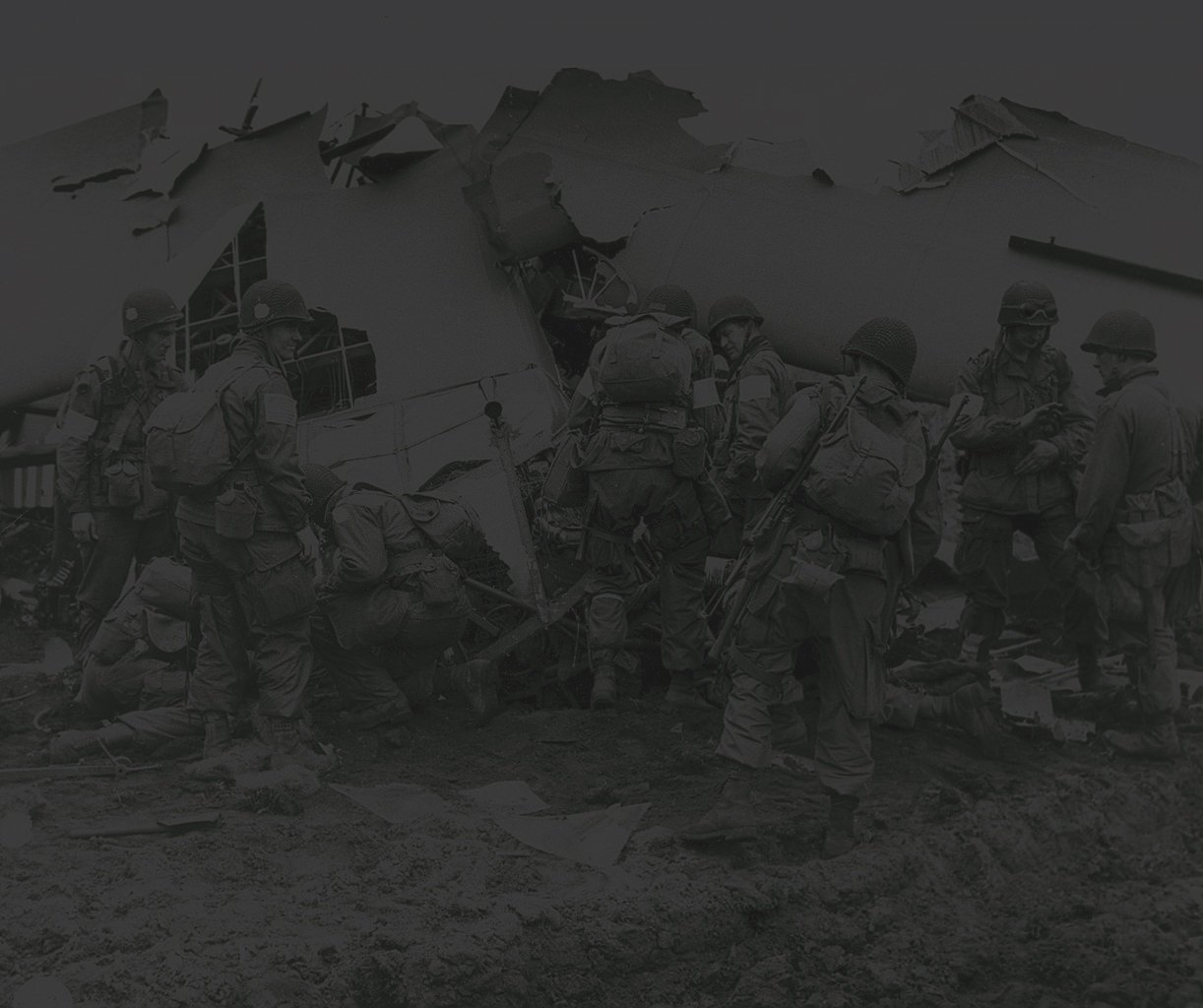
Featured Biographies
Your Story
Do you have a relative or someone close to you who served with the 101st Airborne Division? Post on X (Twitter) using #ScreamingEagles and your post could be featured here!
Posts must be publicly viewable and NOT set to private sharing setting. Photos are encouraged!
My husband, COL (ret) Brad Cook, served with the 101st Airborne Division (Air Assault) from 1995 - 1999. (501st Signal Battalion and 6-101 Aviation Regiment)
— Ann (@theanncook) November 19, 2024
AIR ASSAULT! #ScreamingEagles
Pictured: Air Assault School graduation day and promotion to Captain with family. pic.twitter.com/RcgOcQYM79
Go Army! Beat Navy! #ScreamingEagles pic.twitter.com/3j1Pl9ZRM3
— Jim Daigle (@JimDaigle4) November 18, 2024
82-85, 3rd Brigade. Rakkasan! pic.twitter.com/AfO5YMiuEe
— Merlin🌈&Freyja & Sylvester & Puck (@Merlin80643296) November 19, 2024
This is so cool. Great uniforms. And great that they are honoring the #ScreamingEagles.
— PB Martinez (@PBMartinez1) November 19, 2024
I hate to take sides when it comes to our military forces. But for this game, and in honor of my dad, I say: GO ARMY!! 🏈⭐️ https://t.co/83qanZDw3X
Both my father and I have proudly served in the 101st #ScreamingEagles pic.twitter.com/WVCoVIxOSX
— Michael Gundrum (@MichaelGundrum1) November 21, 2024
Awesome to see West Point honoring my father-in-law's @101stAASLTDIV! #screamingeagles https://t.co/ow4bs7zIOt
— Jill Castilla (@JillCastilla) November 21, 2024
#ScreamingEagles Army Retired and 82nd & 101st. pic.twitter.com/iDhJRykNKx
— Msohio1 (@Msohio1) November 23, 2024
Sandbag mural taken in 2013 at 2-327 IN headquarters at FOB Joyce in Kunar Province, Afghanistan.#ScreamingEagles #Bastogne#GoArmy #BeatN pic.twitter.com/nCRaMqEzkR
— Thomas Bounds (@Hail_To_M) November 19, 2024
#ScreamingEagles pic.twitter.com/60KmWzHGJs
— Dolph (@Dolph_DFS) November 19, 2024
My husband, COL (ret) Brad Cook, served with the 101st Airborne Division (Air Assault) from 1995 - 1999. (501st Signal Battalion and 6-101 Aviation Regiment)
— Ann (@theanncook) November 19, 2024
AIR ASSAULT! #ScreamingEagles
Pictured: Air Assault School graduation day and promotion to Captain with family. pic.twitter.com/RcgOcQYM79
The dudes and I in Iraq!! Go Army pic.twitter.com/qDD4amCsX3
— Mattrix (@Mattrix_irl) November 18, 2024
My dad James, a Vietnam veteran and Army reserve for 25+ years. He also won the national drill sergeant of the year award in 1990 while in the reserves pic.twitter.com/XbqVb8RjBc
— Will Ashwood (@ashwood_will) November 19, 2024
Love the helmets + who they honor @ArmyWP_Football! My great-grandpa James A. Akers served 23 years with the 101st Airborne Rangers. @101stAASLTDIV #ScreamingEagles #GoArmy https://t.co/7RzZIKwfRO pic.twitter.com/OLjNG5f3n0
— Rosco Jasper (@jasper_rosco) November 19, 2024
Me in 2017 w/ PFC Brad Freeman, the last surviving member of E Co., 506th PIR (HBO’s Band of Brothers fame). Unfortunately in 2021 he passed. I served 8+ years in the 101st and will always treasure wearing Old Abe on both shoulders because of warriors like him! #ScreamingEagles pic.twitter.com/sGt5Mf9eJj
— Kevin D (@therealdohjr) November 20, 2024
Can’t wait to see @ArmyWP_Football take the field this weekend in their cool uniforms honoring @101stAASLTDIV! My Uncle dropped into Normandy on D-Day, changing the course of history. Thank you for recognizing them for their sacrifice. Go Army! #ScreamingEagles pic.twitter.com/VhhdJKhCa9
— Jeff Fernandez (@JfernandezJeff) November 22, 2024
Can’t wait to see @ArmyWP_Football take the field this weekend in their awesome uniforms honoring @101stAASLTDIV!
— ArmyVet101 (@mark89044) December 11, 2024
Proud to have served with A Co 3/327 INF, 101st ABN DIV. Honoring the legacy of those who came before us.
GO ARMY - BEAT NAVY! 💪 #ScreamingEagles #AirAssault pic.twitter.com/A7fyhXCXsz
#screamingeagles Proud Army Mom. Coming home from last deployment. pic.twitter.com/5F7QdtER2f
— Michele Brinsfield (@BradySarasmom) November 19, 2024
#ScreamingEagles pic.twitter.com/fcWyhnnaxA
— Liz (@Liz5145403) November 19, 2024
@ArmyWP_Football a much younger me when I was with the 101st. Over 20 years later, and I can still sing the division song! Air Assault! #ScreamingEagles pic.twitter.com/O5A3xbn05M
— David C. McGuire 🎗️✝️🇮🇱 (@PDavidCMcGuire) November 19, 2024
Yes, my husband great great grandfather fought in the civil war, and my husband was in Vietnam all the Lehmann serve in every war.
— Maria Lehmann (@MariaLe98335236) November 18, 2024
My father, Bill Howard, was in the 101st, 506th, at Bastogne. pic.twitter.com/qkIB2uLByj
— Bill Howard (@billhowardesq) November 19, 2024
My son @robbiemaylorDDS served in the dental clinic at @FortCampbell #ScreamingEagles #goarmybeatnavy #hooah pic.twitter.com/wtmYuUmeDo
— Rob ❌aylor 🇺🇸💪🏻🇺🇸 (@bucksdad42) November 19, 2024
My dad, SGT John C. Pons
— mpzimmerman (@mpz267) November 20, 2024
WW II 101st Airborne
502nd
Co H
3rd Battalion
#ScreamingEagles pic.twitter.com/2VIPoWKzzc
I am a Proud Army Aunt!! 2-506, 3rd Brigade Combat Team, 101st Airborne Division- Air Assault 🇺🇸 #ScreamingEagles #Rakkasans #WhiteCurrahee pic.twitter.com/TdFI995gfd
— Jaclyn K. Donovan (@J_K_Donovan) November 22, 2024
#ScreamingEagles Army Retired and 82nd & 101st. pic.twitter.com/iDhJRykNKx
— Msohio1 (@Msohio1) November 23, 2024















